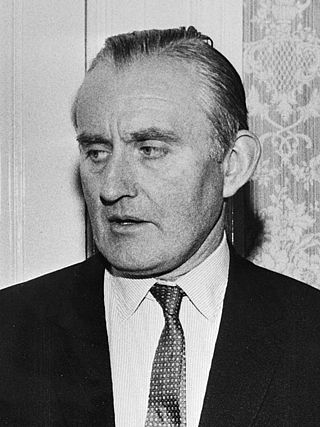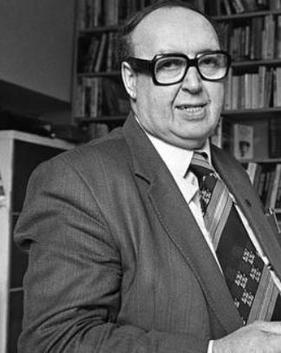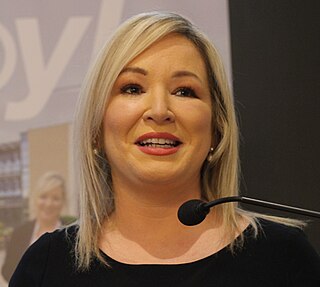
The Parliament of Northern Ireland was the home rule legislature of Northern Ireland, created under the Government of Ireland Act 1920, which sat from 7 June 1921 to 30 March 1972, when it was suspended because of its inability to restore order during The Troubles, resulting in the introduction of Direct Rule. It was abolished under the Northern Ireland Constitution Act 1973.

James Dawson Chichester-Clark, Baron Moyola, PC, DL was the penultimate Prime Minister of Northern Ireland and eighth leader of the Ulster Unionist Party between 1969 and March 1971. He was Member of the Northern Ireland Parliament for South Londonderry for 12 years, beginning at the by-election to replace his grandmother, Dame Dehra Parker in 1960. He stopped being an MP when the Stormont Parliament was suspended and subsequently abolished with the introduction of Direct Rule by the British Government.

The Senate of Northern Ireland was the upper house of the Parliament of Northern Ireland created by the Government of Ireland Act 1920. It was abolished with the passing of the Northern Ireland Constitution Act 1973.

The House of Commons of Northern Ireland was the lower house of the Parliament of Northern Ireland created under the Government of Ireland Act 1920. The upper house in the bicameral parliament was called the Senate. It was abolished with the passing of the Northern Ireland Constitution Act 1973.

The Northern Ireland Labour Party (NILP) was a political party in Northern Ireland which operated from 1924 until 1987.
Anne Letitia Dickson CBE is a former Northern Ireland Unionist politician.
The Ulster Liberal Party was a liberal and non-sectarian political party in Northern Ireland linked to the British Liberal Party. The party was officially neutral on the constitutional position of Northern Ireland. Members expressed different views on the issue but agreed that Northern Ireland could only join the Republic of Ireland if that was the wish of the majority of the people of Northern Ireland.

Patrick Joseph "Paddy" Devlin was an Irish socialist, labour and civil rights activist and writer. He was a founding member of the Social Democratic and Labour Party (SDLP), a former Stormont MP, and a member of the 1974 Power Sharing Executive.
Sheelagh Mary Murnaghan, was an Ulster Liberal Party Member of Parliament (MP) in the House of Commons of Northern Ireland at Stormont from 1962 to 1969.
John Beattie was a Northern Ireland Labour Party (NILP) politician from Northern Ireland. He was a teacher by profession. In 1925, he became a Member of the Northern Ireland House of Commons for Belfast East. He represented Belfast Pottinger from 1929. At one point he served as leader of the NILP.
Henry Cassidy Midgley, PC (NI), known as Harry Midgley was a prominent trade-unionist and politician in Northern Ireland. Born to a working-class Protestant family in Tiger's Bay, north Belfast, he followed his father into the shipyard. After serving on the Western Front in the Great War, he became an official in a textile workers union and a leading light in the Belfast Labour Party (BLP). He represented the party's efforts in the early 1920s to provide a left opposition to the Unionist government of the new Northern Ireland while remaining non-committal on the divisive question of Irish partition.

David Wylie Bleakley CBE was a politician and peace campaigner in Northern Ireland.
Events during the year 1924 in Northern Ireland.
Frederick Vivian Simpson was a politician in Northern Ireland.
Albert Horatio McElroy was a minister of religion and politician in Northern Ireland.
The House of Commons Act 1929 was an Act of the Parliament of Northern Ireland at Stormont which changed the usual voting system used for the House of Commons of Northern Ireland from single transferable vote (STV) to first past the post (FPTP). As a consequence, the act also subdivided nine of the ten multiple-seat constituencies established by the Government of Ireland Act 1920 into 48 single-seat constituencies. The only exception was the Queen's University constituency, which remained STV under a plural voting system until its 1969 abolition. The act was passed in time for the 1929 Stormont election.
George Murnaghan was an Irish Nationalist Member of Parliament in the Parliament of the United Kingdom. He represented the Mid Tyrone constituency from the 1895 United Kingdom general election, until the January 1910 United Kingdom general election.
Mary Simpson was a unionist politician in Northern Ireland.

The 2022 Northern Ireland Assembly election was held on 5 May 2022. It elected 90 members to the Northern Ireland Assembly. It was the seventh assembly election since the establishment of the assembly in 1998. The election was held three months after the Northern Ireland Executive collapsed due to the resignation of the First Minister, Paul Givan (DUP), in protest against the Northern Ireland Protocol.







